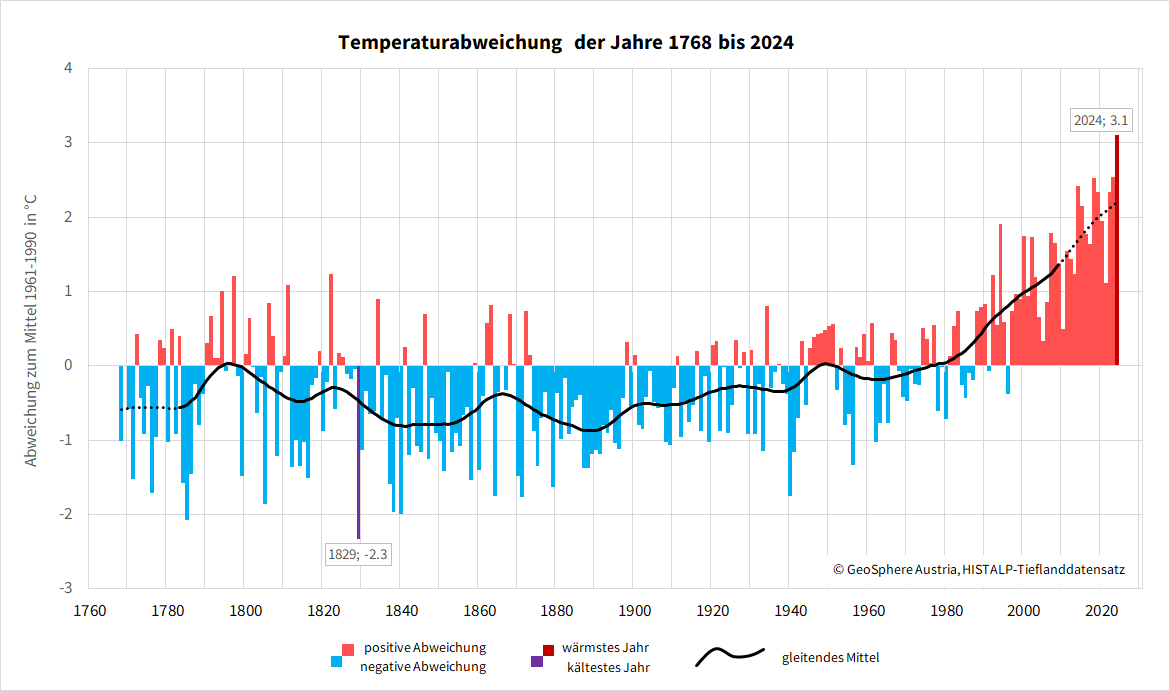Warmest year in recorded history
Preliminary annual assessment by GeoSphere Austria: By far the warmest year in recorded history in Austria's lowlands and mountains. Above-average precipitation (+8 per cent) and slightly below-average number of hours of sunshine (-3 per cent) in the Austria-wide evaluation.
"2024 was by far the warmest year in Austria's measurement history," says climatologist Alexander Orlik from GeoSphere Austria, "taking into account the forecasts for the last days of the year, 2024 was 1.8 degrees warmer in Austria's lowlands and on the mountains than an average year in the already very warm climate period 1991 to 2020. This puts the lowlands in first place in the series of the warmest years in the 257-year measurement history and the mountains in first place in the 173-year mountain measurement series."
Compared to the 1961 to 1990 climate period, which was not yet as severely affected by global warming, the year 2024 is 3.1 degrees above average in the lowlands and 3.0 degrees above average in the mountains.
2024 confirms the trend towards an increasingly warmer climate. The 25 warmest years in the 257-year measurement history are almost exclusively years from the recent past: 2024, 2023, 2018, 2014, 2022, 2019, 2015, 2020, 1994, 2007, 2016, 2000, 2002, 2008, 2017, 2011, 2012, 2009, 1822, 2013, 1992, 1797, 2003, 2021, 1811 (HISTALP lowlands analysis).
2024 started with the second warmest winter in recorded history, followed by the warmest spring and the warmest summer. There were only a few phases that were significantly too cool, such as in mid-September: on 17 September, the weather station at the Rudolfshütte in the Hohe Tauern (S, 2320 metres above sea level) recorded the highest snow depth in a September since measurements began here in 1980 at 145 centimetres.
However, the majority of the records involved excessively high temperatures. For example, 100 of the approximately 290 GeoSphere Austria weather stations recorded new record high temperatures in April and 30 stations recorded new record high temperatures in September.
The weather stations Wien Innere Stadt (52 hot days), Eisenstadt (48), Wien Hohe Warte (45) and St. Pölten (42) recorded a new record number of hot days (at least 30 degrees) in 2024.
The amount of precipitation averaged over the entire area of Austria in 2024 was eight per cent above average. It was therefore one of the 30 years with the most precipitation in the 167-year precipitation measurement series. This was largely due to the extremely wet September, which caused devastating flooding, especially in the eastern half of the country.
An example of the influence of the extreme rainfall in September on the overall balance: In St. Pölten, it rained 409 millimetres in five days in mid-September. That is a large part of the rainfall of an average year in St. Pölten (723 millimetres). In total, there was around 1050 millimetres of precipitation in St. Pölten in 2024 (around 50 per cent more than average).
July and August (around 25 to 35 per cent less precipitation than average) and November (around 70 per cent less precipitation) were significantly too dry in Austria in 2024.
The high temperatures led to early plant development and a late end to the growing season.
Overall, the growing season in 2024 was two weeks longer than in an average year in the 1991–2020 climate period and four weeks longer than in the 1961–1990 climate period. This puts it in 7th place in the 75-year phenological observation series. The year 2020 remains in first place with a deviation of a good three weeks from the 1991–2020 average and a good five weeks from 1961–1990.
Some spring phases in 2024 were the earliest in recorded history. The apricot blossom, for example, was the earliest in the entire observation period from 1946 to 2024 (2nd March on average in Austria), with a lead of around three weeks compared to the average from 1991–2020 and four weeks compared to the average from 1961–1990. The blossoming of the apple, lilac, black elderberry and knotgrass as well as the ripening of the currant also reached their earliest onset dates since 1946 this year.
The foliage on trees and shrubs remained green well into October. Apple leaves, for example, began to change colour on 23 October, two weeks later than the 1961–1990 average.
Translated with DeepL.com (free version)

